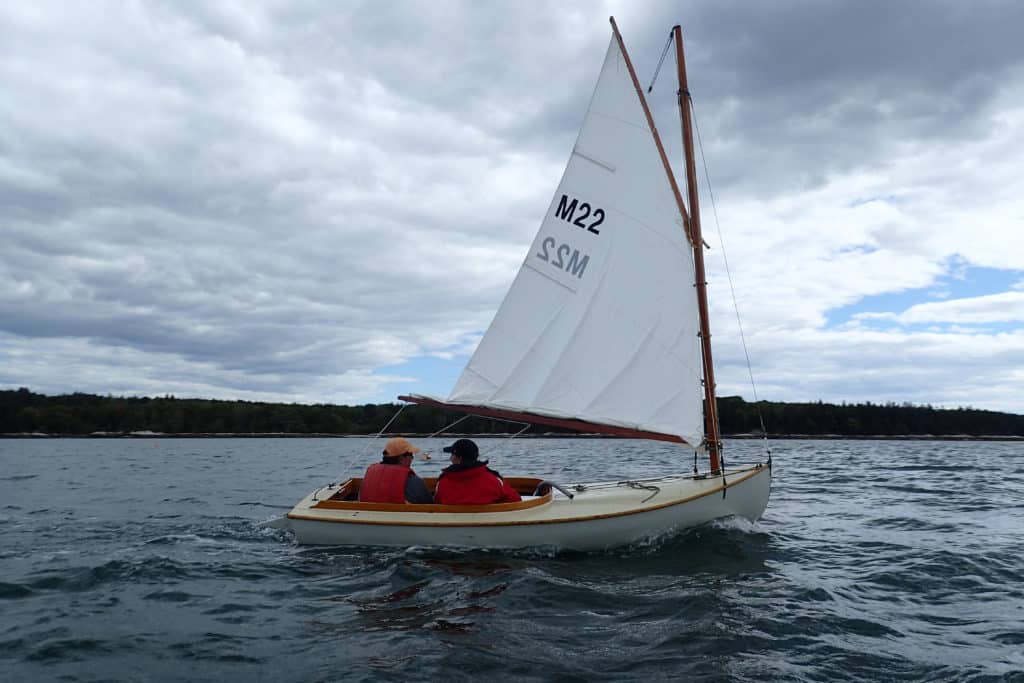
“Blustery” comes to mind when I think of the crisp, cool and sunny Saturday morning last fall when a friend in an inflatable dropped me off on the little sailboat the Pillsbury clan had just inherited from a wooden-boat lover in Maine. I wore a pair of flip-flops, knowing my feet were about to get plenty wet, and I pulled my foul-weather pants up over my knees in the hopes of keeping them dry for later. The first order of the day: grab a bucket and start bailing the many gallons of cold seawater that had Mouse riding noticeably bow-down at her mooring.
Mouse, I should explain, is a Beetle Cat that, up until a few days earlier, had lived a well-cared-for life with a family on Vinalhaven, an island off Midcoast Maine. I’d been told that their collection of wooden boats had expanded to the tipping point, and so, by way of a friend of my brother, Dave, Mouse had found her way to the mainland and then to us.
Her maiden voyage, or should I say our maiden voyage with Mouse, had occurred the night before, with the sun setting fast. After backing her trailer down the ramp at the head of Hatchet Cove, in Friendship, a few pals and I managed to put a good dent in a box of cold ones as we sorted out the still-foreign elements of a gaff-rigged catboat: throat and peak halyards, tack line, outhaul, mainsheet, mast hoops, centerboard, transom-hung barn-door rudder. Then, with the mast raised and sail bent on, there was nothing left to do but push her in and see what would happen.
A light northerly blew us into deeper water, and Dave and I gingerly raised the main. Just like that, we were sailing. We sat on the gray wooden sole, our backs resting comfortably against the varnished coamings as Mouse danced along. Effortlessly, we glided downwind past rocky islands and working docks loaded with lobster traps, and as darkness fell, we rounded up smartly at a borrowed mooring. It was a first sail that couldn’t be beat.
The next morning, as friends rigged a couple of other small boats for a day out on Muscongus Bay, my wife, Sue, joined me once the bailing was finished. We were eager to get going and had the main up in no time. With the sail backed, Sue dropped the pendant and the bow swung off. A front had pushed through overnight, and Friday’s light breeze had been replaced by a boisterous northwesterly, the strength of which only became apparent when we left the lee of the shore. In the open bay, whitecaps were in abundance. Suddenly, the diminutive 12-foot boat felt tiny indeed. I quickly tacked and headed back to grab the first mooring buoy we could find with a line on it. It had been a quick ride, but already there was plenty of reason to pump the bilge. Mouse, it seemed, hadn’t entirely swollen up yet. While Sue manned the Thirsty Mate, I figured out how to reef a gaff-rigged sail.
With just a handkerchief flying, we set out anew, now chasing the somewhat bigger boats in our little armada as they ran toward Friendship Harbor. The farther we got from land, the stronger the breeze blew. In the gusts, well into the mid- to high 20s, the tiller was a beast. A couple of times we rounded up in bigger puffs — once when we were uncomfortably close to a large outcropping of granite. I wouldn’t call it a relaxing sail, but the farther we went, the more Mouse proved her mettle.
If I eased the main a bit more than I would on our big sailboat with its Marconi rig, the overbearing weather helm vanished. On the wind, with a little feathering, Mouse sailed flat and dry, with any spray falling on her beamy foredeck. All afternoon we tacked and reached and ran, tracing big ragged circles past islands and rocky ledges. Once, sailing dead downwind, even with just the scrap of sail, we kept apace of a 19-footer flying a full main and jib.
Sunday, with the northwesterly still on, Dave and I went out and did it all over again. What a hoot. Mouse roared.








